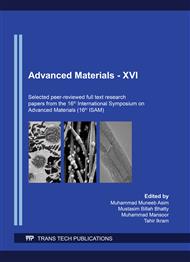[1]
R. Devi, P.R. Devi, K.G. Dhanalakshmi, Applications of mesoporous silica nanomaterial : an over view, Int. J. Adv. Life Sci., 4(2012) 1–9.
Google Scholar
[2]
Y. Zhang, B.Y.W. Hsu, C. Ren, X. Li, J. Wang, Silica-based nanocapsules: Synthesis, structure control and biomedical applications, Chem. Soc. Rev. 44 (2015) 315–335.
DOI: 10.1039/c4cs00199k
Google Scholar
[3]
N. Hao, L. Li, F. Tang, Shape-mediated biological effects of mesoporous silica nanoparticles, J. Biomed.Nanotechnol.10 (2014) 2508–2538.
DOI: 10.1166/jbn.2014.1940
Google Scholar
[4]
Z. Teng, Y. Han, J. Li, F. Yan, W. Yang, Preparation of hollow mesoporous silica spheres by a sol-gel/emulsion approach, Microporous Mesoporous Mater., 12(2010) 67–72.
DOI: 10.1016/j.micromeso.2009.06.028
Google Scholar
[5]
H.M. Abdelaal, Fabrication of hollow silica microspheres utilizing a hydrothermal approach, Chinese Chem. Lett. 25(2014) 627–629.
DOI: 10.1016/j.cclet.2014.01.043
Google Scholar
[6]
Y. Yang, C. Yu, Advances in silica based nanoparticles for targeted cancer therapy, Nanomed. Nanotech. Biol. Med.12(2015) 317–332.
Google Scholar
[7]
W.H. De Jong, P.J.A. Borm, Drug delivery and nanoparticles : Applications and hazards, Int. J. Nanomedicine 3 (2008) 133–149.
Google Scholar
[8]
A.C. Anselmo et al., Elasticity of Nanoparticles Influences Their Blood Circulation, Phagocytosis , Endocytosis and Targeting, ACS Nano, (2015).
DOI: 10.1021/acsnano.5b00147
Google Scholar
[9]
I. Rukshin, J. Mohrenweiser, P. Yue, S. Afkhami, Modeling Superparamagnetic Particles in Blood Flow, Fluids, 2. (2017) 1–12.
DOI: 10.3390/fluids2020029
Google Scholar
[10]
L.R. Shobin, D. Sastikumar, S. Manivannan, Sensors and Actuators A : Physical Glycerol mediated synthesis of silver nanowires for room temperature ammonia vapor sensing, Sensors Actuators A. Phys. 214 (2014) 74–80.
DOI: 10.1016/j.sna.2014.04.017
Google Scholar
[11]
M. Chen, A. Von Mikecz, Formation of nucleoplasmic protein aggregates impairs nuclear function in response to SiO2 nanoparticles, Exp. Cell Res. 305(2005) 51–62.
DOI: 10.1016/j.yexcr.2004.12.021
Google Scholar
[12]
Y.S. Lin, C.L. Haynes, Impact of mesoporous silica nanoparticles and pore integrity on hemolytic activity, J. Am. Chem. Soc. 132 (2010) 4834–4842.
DOI: 10.1021/ja910846q
Google Scholar
[13]
H.F. Krug, R. Wottrich, S. Diabate, Biological effects of ultrafine model particles in human macrophages and epithelial cells in mono- and co-culture, Int. J. Hyg. Environ. Health 207 (2004) 353–361.
DOI: 10.1078/1438-4639-00300
Google Scholar
[14]
T.J. Brunner, P. Wick, A. Bruinink, In Vitro Cytotoxicity of Oxide Nanoparticles : Comparison to Asbestos, Silica, and the Effect of Particle Solubility, Environ. Sci. Technol. 40 (2006) 4374–4381.
DOI: 10.1021/es052069i
Google Scholar
[15]
X. Huang et al., The shape effect of mesoporous silica nanoparticles on biodistribution, clearance, and biocompatibility in vivo, ACS Nano 5 (2011) 5390–5399.
DOI: 10.1021/nn200365a
Google Scholar
[16]
C. Line, In Vitro Cytotoxicitiy of Silica Nanoparticles at High Concentrations Strongly Depends on the Metabolic Activity Type of the Cell Line, Environ. Sci. Technol. 41 (2007) 2064–(2068).
DOI: 10.1021/es062347t.s001
Google Scholar
[17]
M.A. Rida, F. Harb, Synthesis and Characterization of Amorphous Silica Nanoparitcles from Aqueous Silicates using Cationic Surfactants, J. Met. Mater. Miner. 24 (2014) 37–42.
Google Scholar
[18]
B.U. Yoo, M.H. Han, H.H. Nersisyan, J.H. Yoon, K.J. Lee, J.H. Lee, Self-templated synthesis of hollow silica microspheres using Na2SiO3 precursor, Microporous Mesoporous Mater. 190 (2014) 139–145.
DOI: 10.1016/j.micromeso.2014.02.005
Google Scholar
[19]
A. Petushkov, N. Ndiege, A.K. Salem, S.C. Larsen, Toxicity of silica nanomaterials: Zeolites, mesoporous silica, and amorphous silica nanoparticles, Adv. Molec. Toxic. 4(2010) 223-266.
DOI: 10.1016/s1872-0854(10)04007-5
Google Scholar
[20]
K.Walczak-zeidler, I. Nowak, UV-Vis and IR techniques for drug identification in porous carriers, Chemik 65 (2011) 643–648.
Google Scholar


